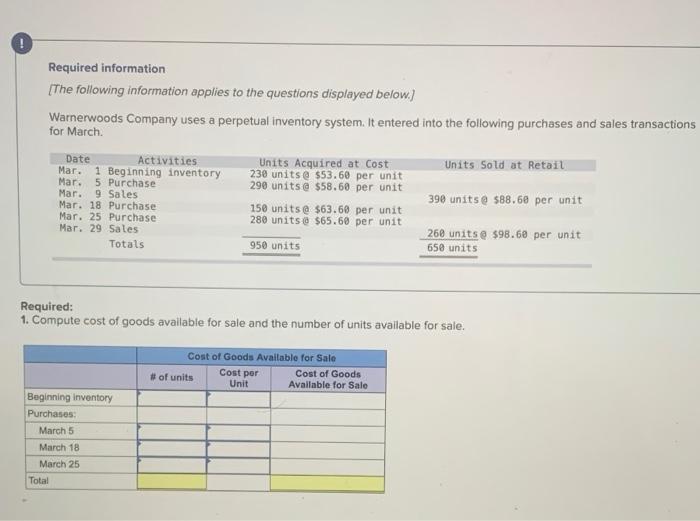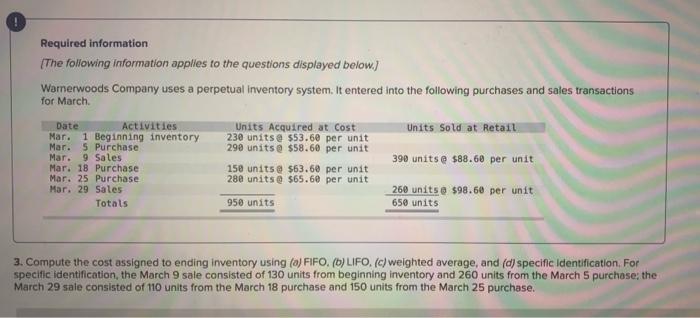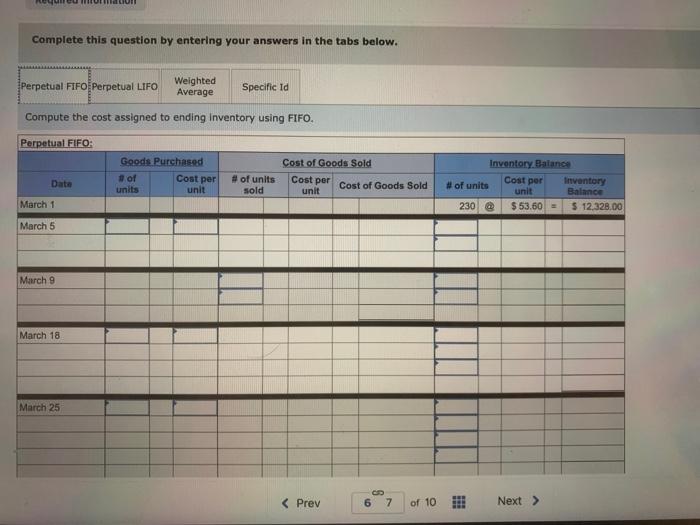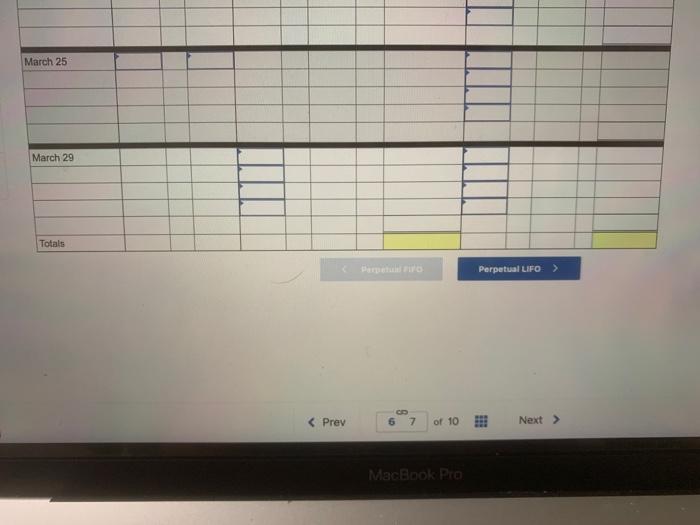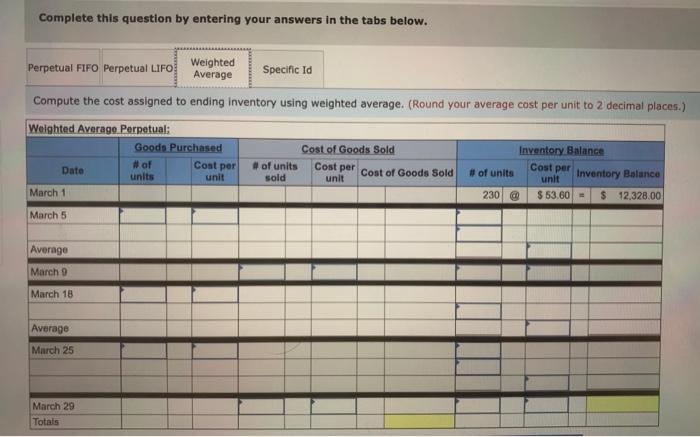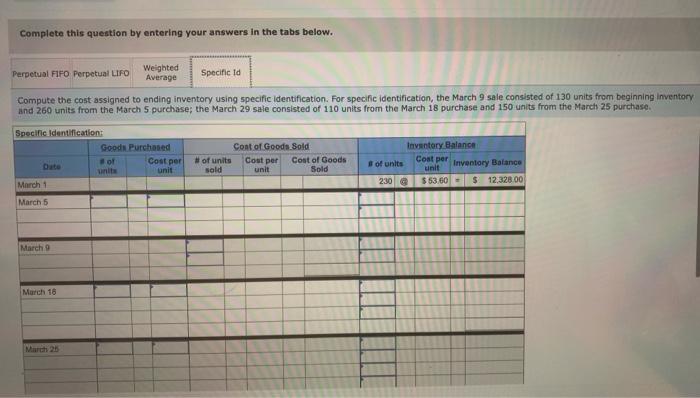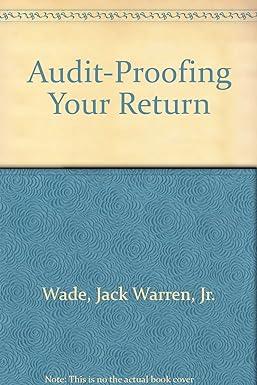! Required information [The following information applies to the questions displayed below.) Warnerwoods Company uses a perpetual inventory system. It entered into the following purchases and sales transactions for March Units sold at Retail Date Activities Mar. 1 Beginning inventory Mar. 5 Purchase Mar. 9 Sales Mar. 18 Purchase Mar. 25 Purchase Mar. 29 Sales Totals Units Acquired at Cost 238 units@ $53.60 per unit 290 units @ $58.60 per unit 150 units @ $63.60 per unit 280 units @ $65.60 per unit 390 units @ $88.68 per unit 950 units 260 units@ $98.68 per unit 650 units Required: 1. Compute cost of goods available for sale and the number of units available for sale. Cost of Goods Available for Sale Cost per Cost of Goods # of units Unit Available for Sale Beginning inventory Purchases March 5 March 18 March 25 Total Required information [The following information applies to the questions displayed below.) Warnerwoods Company uses a perpetual inventory system. It entered into the following purchases and sales transactions for March Units sold at Retail Date Activities Mar. 1 Beginning inventory Mar. 5 Purchase Mar. 9 Sales Mar. 18 Purchase Mar. 25 Purchase Mar. 29 Sales Totals Units Acquired at Cost 230 units @ $53.60 per unit 290 units@ $58.68 per unit 158 units @ $63.68 per unit 280 units @ $65.60 per unit 390 units @ $88.60 per unit 260 units @ $98.68 per unit 650 units 950 units 2. Compute the number of units in ending inventory. Ending intory Punith Required information (The following information applies to the questions displayed below.) Wamerwoods Company uses a perpetual inventory system. It entered into the following purchases and sales transactions for March Units sold at Retail Date Activities Mar. 1 Beginning inventory Mar. 5 Purchase Mar. 9 Sales Mar. 18 Purchase Mar. 25 Purchase Mar. 29 Sales Totals Units Acquired at Cost 230 units@ $53.60 per unit 298 units @ $58.60 per unit 158 units @ $63.60 per unit 288 units@ $65.60 per unit 390 units @ $88.68 per unit 260 units@ $98.60 per unit 650 units 950 units 3. Compute the cost assigned to ending inventory using (0) FIFO. (D) LIFO. (c) weighted average, and (d) specific Identification. For specific identification, the March 9 sale consisted of 130 units from beginning inventory and 260 units from the March 5 purchase the March 29 sale consisted of 110 units from the March 18 purchase and 150 units from the March 25 purchase. Complete this question by entering your answers in the tabs below. Perpetual FIFO Perpetual LIFO Weighted Average Specific Id Compute the cost assigned to ending Inventory using FIFO. Perpetual FIFO: Cost of Goods Sold Goods Purchased # of units unit Date Cost per of units sold Cost per Inventory.Balance Cost per Inventory # of units unit Balance 230 $53.60 = $ 12,328.00 unit Cost of Goods Sold March 1 March 5 March 9 March 18 March 25 March 25 March 29 Totals Perpetual LIFO > MacBook Pro Required information Perpetual FIFO perpetual LIFO Weighted Average Specific Id Compute the cost assigned to ending inventory using LIFO. Perpetual LIFO: Cost of Goods Sold Goods Purchased of Cost per units unit Date # of units sold Cost per unit Cost of Goods Sold Inventory Balance Cost per # of units Inventory unit Balance 230 @ $ 53,60 = $ 12,328.00 March 1 March 5 March 9 March 18 March 25 March 29 March 29 Totals Complete this question by entering your answers in the tabs below. Perpetual FIFO Perpetual LIFO Weighted Average Specific Id Compute the cost assigned to ending inventory using weighted average. (Round your average cost per unit to 2 decimal places.) Weighted Average Perpetual: Goods Purchased Cost of Goods Sold Inventory Balance #of Cost per # of units Date Cost per cost of Goods Sold units # of units unit sold unit unit March 1 230 $ 53.60 = $ 12,328.00 Cost per Inventory Balance March 5 Average March 9 March 18 Average March 25 March 29 Totals Complete this question by entering your answers in the tabs below. Perpetual FIFO Perpetual LIFO Weighted Average Specific la Compute the cost assigned to ending inventory using specific identification. For specific identification, the March 9 sale consisted of 130 units from beginning Inventory and 260 units from the March 5 purchase; the March 29 sale consisted of 110 units from the March 18 purchase and 150 units from the March 25 purchase. Specific Identification: Goods Purchased . Cost per unit March 1 March 5 Coat of Goods Sold # of units Cost per Cost of Goods sold unit Sold Inventory Balance of units 230 $ 53,60 = $ 12,328.00 Coat per Inventory Balance March 9 March 16 Mar 25 March 25 March 29 Totals ! Required information (The following information applies to the questions displayed below.) Warnerwoods Company uses a perpetual Inventory system. It entered into the following purchases and sales transactions for March Units Sold at Retail Date Activities Mar. 1 Beginning inventory Mar. 5 Purchase Mar. 9 Sales Mar. 18 Purchase Mar. 25 Purchase Mar. 29 Sales Totals Units Acquired at Cost 230 units @ $53.60 per unit 290 units@ $58.60 per unit 150 units@ $63.60 per unit 280 units @ $65.60 per unit 390 units@ $88.68 per unit 260 units $98.50 per unit 650 units 950 units 4. Compute gross profit earned by the company for each of the four costing methods. For specific identification, the March 9 sale consisted of 130 units from beginning inventory and 260 units from the Morch 5 purchase; the March 29 sole consisted of 110 units from the March 18 purchase and 150 units from the March 25 purchase. (Round weighted average cost per unit to two decimals and final answers to nearest whole dollar.) FIFD LIFO Avg. Cost Spec. ID Gross Marin Sales Less Coat of goods sold Gross profit
